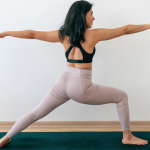Barely two months after graduating from my 200-hour teacher training course, I landed a regular teaching slot at one of the most exclusive clubs in the UK. This isn’t me bragging, but contemplating ‘how on earth did that happen?!’ How do you land a yoga job when you’re a fresh graduate (or newbie)? What is the magic formula for landing a yoga job? Sometimes it’s an audition and the employer just knows you’ll fit in. Sometimes it’s timing and the gods decide to smile on you that day (and you remember your cues!). Or maybe it’s who you know (and/or how many Instagram followers you have!!), but that discussion is for another article.
Let’s be honest, in the beginning, no matter how good your 200-hour teacher training is, you are still wading your way through mud trying to find your own voice. ‘Just be yourself’ gets bandied about as a solution, but isn’t that similar to being told to ‘act natural’ whilst bending over in a wide-legged forward fold with the entire class fixed intently on your rotund posterior. What does ‘just be yourself’ even mean?
Authentic Butt…
Newbie classes are often a mixture of other teachers’ words combined with images from some Insta video you just watched, teaching the things you are most comfortable with. Then as you gain more experience and knowledge, your teaching develops. Every time I take a course, read a book, learn something new, that information finds its way into my classes. This creates an element of lunacy in my teaching. One week I urge precision of alignment as anatomical names fly through the air like synapses, the next week I ask them to release their inner rainbow and bask in the freedom from the shackles of human existence. If in my classes, I am regurgitating the latest facts, borrowing cool phrases, stealing sequences from other teachers, then ‘what is my authentic voice’?
Rather like a mission statement, this ambiguous authentic voice is hard to define. It requires a clear sense of self and a large dollop of soul searching and even then, there might be a divide between what you think and what you actually do and say. It is an ever-evolving mystery, as slippery as an eel, as elusive as a fairy. My truly authentic voice is curbed when I teach yoga; my cynical, doubting side is turned down (as are my wise-ass jokes). I have my yoga teacher hat on and so I behave. My authentic voice wants to end the class saying ‘the divine light in me can’t really see the divine light in you, because I am so full of my own doubts that I can’t see the tip of my nose, let alone anyone else’s, but Namaste anyway’. But I don’t. My job is to serve the student, give them yoga and not make the class be about me. But even as I write that last sentence, I think I am talking out of my Ashwini mudra, because how can the class not be about me? And what does ‘give them yoga’ even mean?
The expectation of an average, modern-day yoga class is to guide students through a series of poses that stretch and strengthen the body, help them to calm the mind and leave feeling better than when they arrived, all for a moderate price and within 60 minutes or so. We call this yoga.
Seducing You to Enlightenment
In essence, all yoga classes are similar, perhaps a different sequence of poses, maybe some pranayama (breath exercises), maybe some mantra (chanting) and meditation. The teacher’s spiel, the blurb, the pearls of wisdom, the theme is more prominent. No longer would the concise Ashtanga Vinyasa script ‘Uttitha Trikonasana -5 vinyasa -look little finger’ be sufficient, but now you might be encouraged ‘to fill the lungs to 360 degrees, ignite the triceps and biceps to shoot flames from the fingertips. Grow roots into the earth, engage mula bandha to awaken muladhara chakra. Release your inner invincible warrior- Virabhadrasana 2…and exhale”. Suddenly we have a different vibe. The language becomes important and the teacher features more prominently. The onus potentially shifts from student to teacher. It is the teacher who guides, coaxes, allures the students who, in turn, are transported, enticed and seduced into a sense of well-being. That ever-illusive authentic voice is needed here for this delicate work. This too is yoga.
The Absolutely, Definitive Definition of Yoga…
The definition of yoga depends on who and what you read…
“Yoga is the suppression of the activities of the mind” (1.2) Yoga Sutras of Patanjali
“Yoga is fourfold: faith, aspiration, perseverance and means” (2.152) Yogācārabhūmi-Śāstra (Sravakabhumi),
“In this system, yoga is the union of the self and the Lord” (I.I.43) Kaundinya’s Pancarthabhasya on the Pasupatasutra
“Yoga is said to be the oneness of one entity with another.” (MVUT 4.4–8) Mālinīvijayottara Tantra
“Yoga is art of discovering your true self, whilst doing the splits” Cheeky Yogi (😊1.0)
This is only a handful of sources, and let’s not even talk about the myriad different translations affecting these interpretations. So if the definition of what we are teaching is a moving entity, how easy it is to find an authentic voice?
Could I be a Rishi?
Thinking back to the ancient rishis, these men and women spent their lives in intense meditation until they understood the supreme truth. This knowledge came from within them.
A 500-hour yoga diploma and some contemplation do not make me a rishi, but I am living in the same world, with the same fundamental questions and challenges and there is the connection of experience of this same world. So, my thoughts are as valid an experience as the next persons and it is from this perspective that I teach. I listen and learn from others and it isn’t until I have assimilated something, embodied it, incorporated it into my being that it becomes real and authentic. My teaching in class is me humbly saying ‘this is what I have discovered so far, perhaps it resonates with you?’ So is this my authentic voice? Perhaps it wasn’t that hard to find?
Namaste, the Cheeky Yogi 😊













